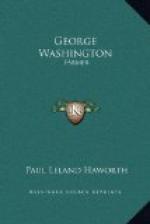Dogs, in fact, constituted an ever present menace to the sheep and it was only by constant watchfulness that the owner kept his negroes from overrunning the place with worthless curs. In 1792 he wrote to his manager: “I not only approve of your killing those Dogs which have been the occasion of the late loss, & of thinning the Plantations of others, but give it as a positive order that after saying what dog, or dogs shall remain, if any negro presumes under any pretence whatsoever, to preserve, or bring one into the family, that he shall be severely punished, and the dog hanged.—I was obliged to adopt this practice whilst I resided at home, and from the same motive, that is for the preservation of my Sheep and Hogs.... It is not for any good purpose Negroes raise, and keep dogs; but to aid them in their night robberies; for it is astonishing to see the command under which the dogs are.”
After the Revolution, in imitation of English farmers, he made use of hurdles in pasturing sheep and milk cows. Thereby he secured more even distribution of the manure, which was one of his main objects in raising stock.
Washington’s interest in cattle seems to have been less intense than was the case with some other kinds of stock. He always had a great number of cows, bulls, oxen and calves upon his farms—in 1793 over three hundred “black cattle” of all sorts. He was accustomed to brand his cattle with the letters “G.W.,” the location of the brand on the body indicating the farm on which the beast was raised. To what extent he endeavored to improve the breed of his cattle I am unable to say, but I have found that as early as 1770 he owned an English bull, which in July he killed and sold to the crew of the British frigate Boston, which lay in the Potomac off his estate. In 1797 he made inquiries looking toward the purchase of an improved bull calf from a cattle breeder named Gough, but upon learning that the price was two hundred dollars he decided not to invest. Gough, however, heard of Washington’s interest in his animals, and being an admirer of the General, gave him a calf. An English farmer, Parkinson, who saw the animal in 1798, describes him in terms the reverse of enthusiastic, and of this more hereafter.
A large part of the heavy work on all the farms was done by oxen. In November, 1785, there were thirteen yoke of these beasts on the Mount Vernon estate and the number was sometimes still larger. In 1786 Washington recorded putting “a Collar on a large Bull in order to break him to the draft.—at first he was sulky and restive but came to by degrees.” The owner always aimed to have enough oxen broken so that none would have to be worked too hard, but he did not always succeed in his aim. When they attained the age of eight years the oxen were usually fattened and killed for beef.




